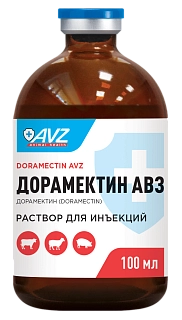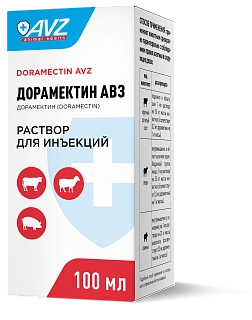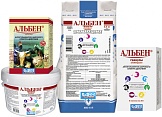Benefits
-
A broad antiparasitic spectrum: nematodes, gadfly larvae, ixodic ticks and Sarcoptes scabiei
-
Long–term protection against parasitic diseases and reinvasion - 28 days
Composition and pharmacological properties.
Doramectin, which is a component of the drug product has a broad-spectrum insecticidal, nematodocidal and acaricidal effects; it is active against intestinal, pulmonary, subcutaneous and lacrimal nematodes, gadfly larvae, as well as lice, louse flies, sarcoptoid and ixodic ticks.
Doramectin (25-cyclohexyl -5-O-dimethyl-25-di (1-methylpropyl) avermectin A1a) belongs to the class of macrocyclic lactones.
Doramectin binds to the receptors on muscle and nervous cells, increases the permeability of membranes to chlorine ions, causing nerve impulses block, which leads to paralysis and death of parasites. Due to the fact that in mammals these receptors are located only in the central nervous system, and doramectin does not penetrate the blood-brain barrier, it is safe for mammalian animals when used at recommended doses.
After parenteral administration, doramectin is readily resorbed from the injection site, and it persists in therapeutic concentrations in the animal body for a long time, providing parasitocidal effect, and long-term (up to 28 days) protection against pathogens of parasitic diseases and reinvasion.
It is excreted mainly unchanged with feces, in lactating animals - partially with milk.
Indications
Doramectin AVZ is prescribed to cattle, sheep and pigs for the treatment and prevention of diseases caused by nematodes of the gastrointestinal tract, lungs, subcutaneous tissue, lacrimal ducts, larvae of subcutaneous and nasopharyngeal gadflies, lice, Sarcoptes scabiei and ixodic ticks.
In cattle, the drug is used for treatment of diseases caused by:
– intestinal nematodes (mature and larvae): Ostertagia ostertagi (including encapsulated larvae), O. lyrata, Haemonchus placei, H. similis, Trichostrongylus axei, T. colubriformis, T. longispicularis, Mecistocirrus digitatus, Cooperia oncophora (including encapsulated larvae), C. pectinata, C. punctata, C. spatulata, C. sumabada (synonym of mcmasteri), Nematodirus helvetianus, N. spathiger, Bunostomum phlebotomum, Strongyloides papillosus, Oesophagostomum radiatum, Trichocephalus discolor, T. ovis;
– pulmonary nematodes (mature and larvae) – Dictyocaulus viviparus;
– lacrimal duct nematodes – Thelazia spp.;
– subcutaneous nematodes – Parafilaria bovicola;
– larvae of subcutaneous gadflies: Hypoderma bovis, Hypoderma lineatum;
– lice: Haematopinus eurysternus, Linognathus vituli, Solenopotes capillatus;
– sarcoptoid mites: Psoroptes bovis, Sarcoptes bovis, Chorioptes bovis;
– ixodic ticks – Boophilus microplus;
– argass mites – Ornithodorus spp.
The drug is used in sheep for treatment of diseases caused by:
– intestinal nematodes: Ostertagia (Teladorsagia) circumcincta (sexually mature and larvae, including those resistant to benzimidazole derivatives), Haemonchus contortus (mature and larvae), Trichostrongilus axei (mature and larvae), T. colubriformis (mature and larvae), T. vitrinus (mature and larvae), Cooperia curticei (larvae), C.oncophora (mature and larvae), Oesophagostomum venulosum (mature), Nematodirus spp. (mature and larvae), Strongyloides papillosus, Trichocephalus ovis;
– pulmonary nematodes – Dictyocaulus filaria;
– sarcoptoid mites: Psoroptes ovis, Sarcoptes ovis;
– larvae of the nasopharyngeal gadfly – Oestrus ovis.
The drug is used in pigs for treatment of diseases caused by:
– intestinal nematodes (adults and larvae): Hyostrongylus rubidus, Ascaris suum, Strongyloides ransomi (mature), Oesophagostomum dentatum, Oesophagostomum quadrispinulatum, Trichocephalus suis;
– pulmonary nematodes (mature) – Metastrongylus spp.;
– renal nematodes (mature) – Stephanurus dentatus;
– lice – Haematopinus suis;
– sarcoptoid mites – Sarcoptes scabiei.
Contraindications.
Individual hypersensitivity of the animal to the components of the drug product (including history thereof) Do not use the drug in pregnant heifers less than 60 days before the expected calving and to pregnant sheep less than 70 days before the expected lambing, if the milk is planned to be used for food purposes. The drug should not be used in animals with infectious diseases and emaciated animals.
Side effects.
When the drug is used in accordance with the instructions, the risk of side effects and complications is negligible. In case of allergic reactions, treatment is discontinued and antihistamines and symptomatic therapy are prescribed.
In case of an overdose, animals may experience depression, lack of appetite, tremor, and hypersalivation. There are no specific antidote. General measures are taken to eliminate the drug from the body.
How to use.
Doramectin AVZ is administered to animals as a single parenteral dose under aseptic conditions, using dry sterile syringes and needles, at following doses:
– cattle – subcutaneously in the area of the neck, 1 ml of solution per 50 kg of animal bodyweight (equivalent to 0.2 mg of doramectin per 1 kg bodyweight);
– sheep – intramuscularly into the neck or posterior femoral muscle group, 1 ml of solution per 50 kg of animal bodyweight (equivalent to 0.2 mg of doramectin per 1 kg bodyweight). In severe scabies, especially in the chronic course of the disease, the dose of the drug can be increased to 1.5 ml per 50 kg of animal bodyweight (equivalent to 0.3 mg of doramectin per 1 kg bodyweight);
– pigs – intramuscularly at the base of the ear, 1 ml of solution per 33 kg of animal bodyweight (equivalent to 0.3 mg of doramectin per 1 kg bodyweight).
When treating animals at <5°C, due to a slight increase in the viscosity of the solution, it is recommended to heat the vial with the drug and syringes to room temperature.
For preventive purpose, the treatment of animals with nematodes is carried out twice a year: in autumn and spring, before pasture, against gadfly infestations – immediately after the end of the period of gadfly activity, against ectoparasites – according to indications.
Special warnings
Do not co-administer Doramectin AVZ with drugs containing macrocyclic lactones, due to the possible increase in toxic effects of both drugs. Data on the interaction of Doramectin AVZ with drugs of other pharmacological groups are lacking.
Specific effects after first dose and withdrawal have not been established.
The drug is intended for single administration.
Storage.
Store in a closed original package in a dry place, protected from direct sunlight, separate from food and feed, at 5°C to 25°C. Keep out of reach of children.
Dosage form.
50, 100 and 500 ml amber glass bottles


















